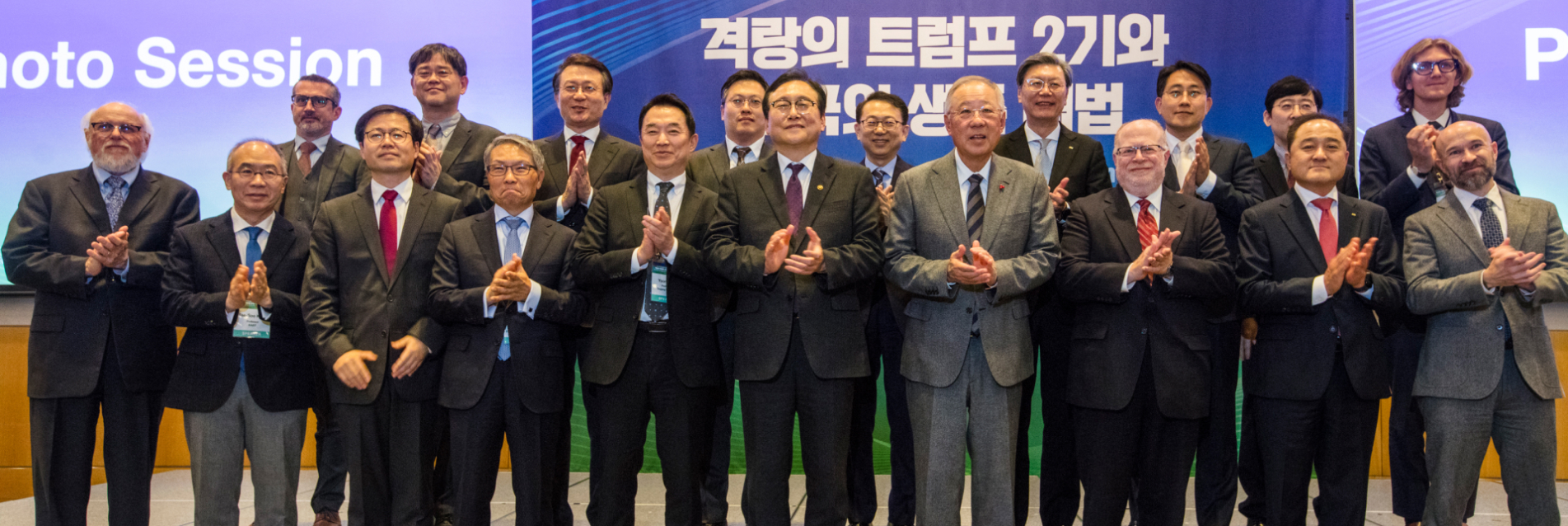2025 Economic Outlook
Strategic Responses
of South Korean Businesses
to Trump’s Second Term
Following the US presidential election that saw Donald Trump reelected, economic and political uncertainties are intensifying. To address these challenges, FKI collaborated with the Peterson Institute for International Economics (PIIE)—a leading global think tank in international economics—to host a joint conference titled “Navigating Trump’s Second Term: South Korea’s Path Through Turbulent Times.” Held in November, the conference examined policy changes during Trump’s second term and discussed strategies for South Korea’s response. Key presentations were delivered by PIIE President Adam Posen and Senior Fellow Jeffrey Schott, providing valuable insights for South Korean business leaders.
Photographer Gyu-cheol Shin, Dong-yeol Kim
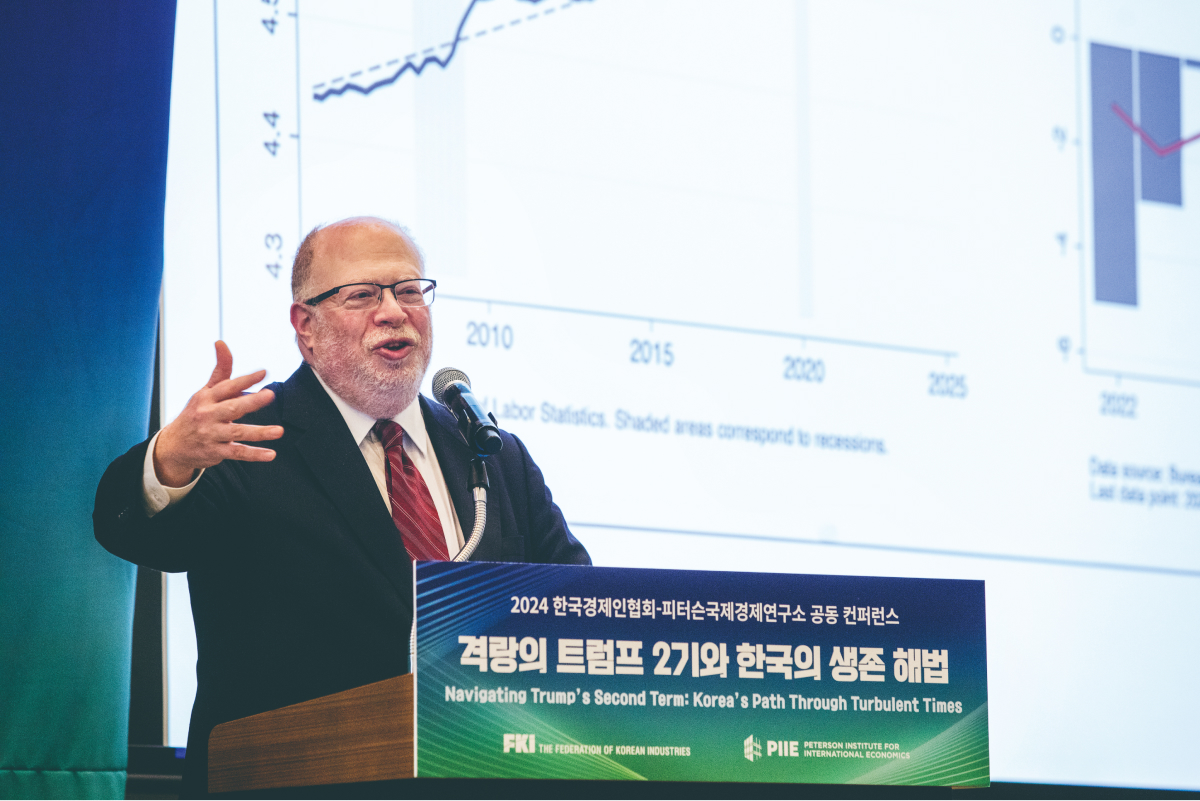
Adam Posen
- President, Peterson Institute for International Economics
Robust US Economic Growth
Despite uncertainties in the global economic outlook for major economies like South Korea, China, and the EU, the US economy under Trump’s second term is expected to maintain strong growth. The US GDP is projected to grow by 2.5% in 2025, sustaining a solid trajectory. Currently on a downward trend due to the Federal Reserve System’s series of interest rate cuts, inflation rates are still expected to exceed the 2% target in the medium term. The strength of the US economy is likely to bolster the US dollar relative to other currencies, further reinforcing its central role in global markets. Contrary to market expectations, the Federal Reserve System may shift its current interest ratecutting stance to a new ratehike cycle by the third quarter of 2025, with potential for further increases in 2026, posing upward risks for interest rates.
The backbone of the US economy’s robust growth lies in improved labor productivity. Gains in labor productivity—which measure output per worker—allow economic expansion without triggering inflationary pressures from higher labor costs. US labor productivity has shown a steady upward trend since 2005, with notable acceleration following the COVID-19 pandemic. This improvement stems from the flexibility of the US labor market, which enabled displaced workers to reallocate to industries with genuine demand; thus enhancing overall efficiency. Moreover, advancements in artificial intelligence have recently begun transforming workplace environments. As businesses increasingly adopt AI technologies, the upward trajectory of US labor productivity is expected to continue; thus further solidifying the economy’s growth potential.
Five Key Policy Changes Expected in Trump’s Second Term
Compared to the Biden administration, Trump’s second term is expected to introduce significant shifts in five key areas: immigration, tariffs, regulations, Federal Reserve System independence, and the federal budget.
First, a strict immigration policy is anticipated. Trump’s administration is expected to implement robust measures to deport undocumented immigrants immediately after taking office on January 20. While forced deportations will incur massive costs, Trump is likely to move forward with this policy due to its strong public support. An estimated 30,000 to 50,000 undocumented immigrants could face deportation shortly after his inauguration.
Second, tariff increases are likely to follow. Having consistently expressed a commitment to raising tariffs, Trump is expected to act swiftly on this matter. However, the degree and intensity of the tariff hikes will vary by country. For nations with large US trade deficits, such as China and Mexico, targeted tariffs are likely to be imposed. In contrast, for allies like South Korea, tariff increases might serve more as a negotiating tool in trade dealings. This means that South Korea must devise strategies to counter potential threats of tariff hikes in future negotiations with the US.
Third, deregulation is expected. Trump may repeal or weaken the energy and environmental regulations enacted during the Biden administration. A slew of administrative orders is anticipated postinauguration, and the South Korean government and businesses will need to monitor these developments closely.
Fourth, the independence of the Federal Reserve System may come under pressure. Although the Federal Reserve System operates independently to achieve its dual objectives of price stability and full employment, Trump’s second term could weaken such independence. One of the factors behind Trump’s election victory was the economic hardship faced by lowincome groups due to the prolonged period of high interest rates. Additionally, Trump had criticized the Federal Reserve System in 2019 for being too slow to cut interest rates to prevent an economic slowdown. As such, he is likely to exert persistent pressure on the Federal Reserve System to lower interest rates.
Finally, significant changes to the federal budget are anticipated. Trump’s proposed tax cuts are expected to exacerbate the US fiscal deficit. To offset some of the revenue losses caused by the tax cuts, Trump plans to leverage increased tariff revenues. He also intends to establish the Department of Government Efficiency (DOGE) to manage the budget more effectively. Thus, monitoring these development closely is critical.
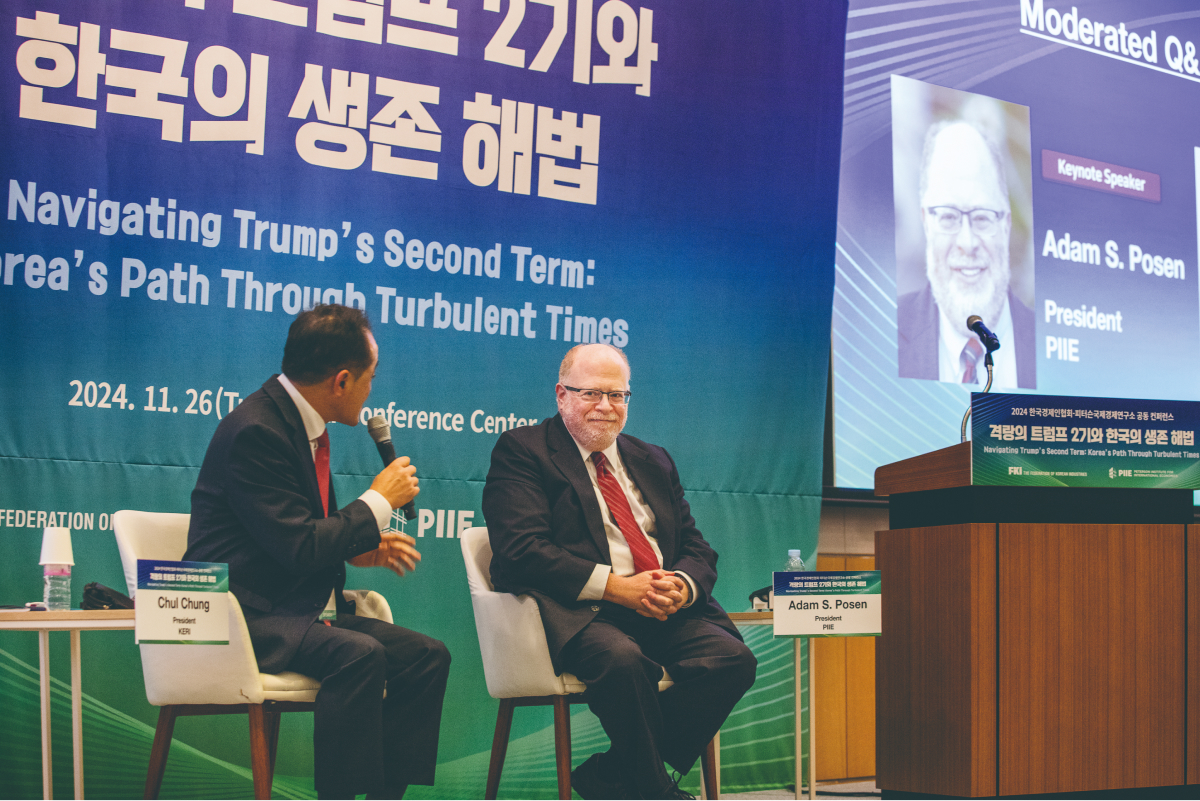
“Compared to the Biden
administration, Trump’s
second term is expected to
introduce significant shifts in
five key areas: immigration,
tariffs, regulations,
Federal Reserve System
independence, and the
federal budget.”
“Compared to the Biden
administration, Trump’s
second term is expected to
introduce significant shifts in
five key areas: immigration,
tariffs, regulations,
Federal Reserve System
independence, and the
federal budget.”
Opportunities and Challenges for the South Korean Economy
How will the policy shifts under Trump’s second term impact the South Korean economy? The effects are likely to be a mix of positives and negatives. On the positive side, robust US economic growth will generally benefit South Korea’s economic expansion. In particular, deregulation in the US energy and environmental sectors is expected to increase energy supply, which could bring shortterm benefits to the South Korean economy. However, the strong US growth may drive a “strong dollar,” leading to a rise in the KRW/USD exchange rate and exacerbating inflationary pressure in South Korea. A weaker Korean won could create a vicious cycle where capital outflows to the US further devalue the currency.
Moreover, the continued global geopolitical instability, the potential resumption of the Federal Reserve System’s interest rate hike cycle starting from Q3 2025, and Trump’s tariff policies are all factors that are likely to reinforce the strong dollar. Unlike the 1980s Plaza Accord, which involved multilateral efforts to correct dollar overvaluation, no such coordination is expected under Trump’s administration. Instead, Trump’s administration might resort to radical measures to curb the dollar’s strength. These combined factors will place the Bank of Korea in a difficult position, forcing it to consider carefully whether to raise its benchmark interest rate.

South Korea’s Survival Strategy Under Trump’s Second Term
How should South Korea and its businesses respond to the anticipated changes under Trump’s second term? First, South Korea must work to integrate itself into the socalled “Fortress America,” the high barriers created by US tariffs and protectionist policies. Just as South Korean semiconductor and automobile companies have expanded investments in the US, South Korea must maintain favorable economic cooperation by increasing its presence within these barriers through strategic investments. Such investments benefit the US economy by creating jobs, providing South Korea with leverage to secure benefits from the Trump administration.
Second, South Korea should diversify its markets and expand economic cooperation beyond the US and China. Joining the Comprehensive and Progressive Agreement for TransPacific Partnership (CPTPP)—an economic pact led by Japan and composed of 11 AsiaPacific nations—would be a crucial step. Furthermore, as Trump’s policies threaten rulebased global systems such as the WTO, South Korea must play a leading role in preserving the international order by strengthening ties with other major players, including Japan, Australia, Canada, and the EU.
Lastly, South Korea must enhance its competitiveness by actively utilizing female and foreign workers. Drawing lessons from the shortcomings of Japan’s Womanomics policy under Prime Minister Shinzo Abe, South Korea should focus on effectively integrating female talent into its workforce. Additionally, as the US and China expected to become less attractive markets for capital and talent, South Korea must seize this opportunity to position itself as a global hub. By leveraging its openness and democratic values, South Korea can offer better incentives to attract international talent. Flexible visa policies and targeted incentives should be implemented to attract the best global talent.
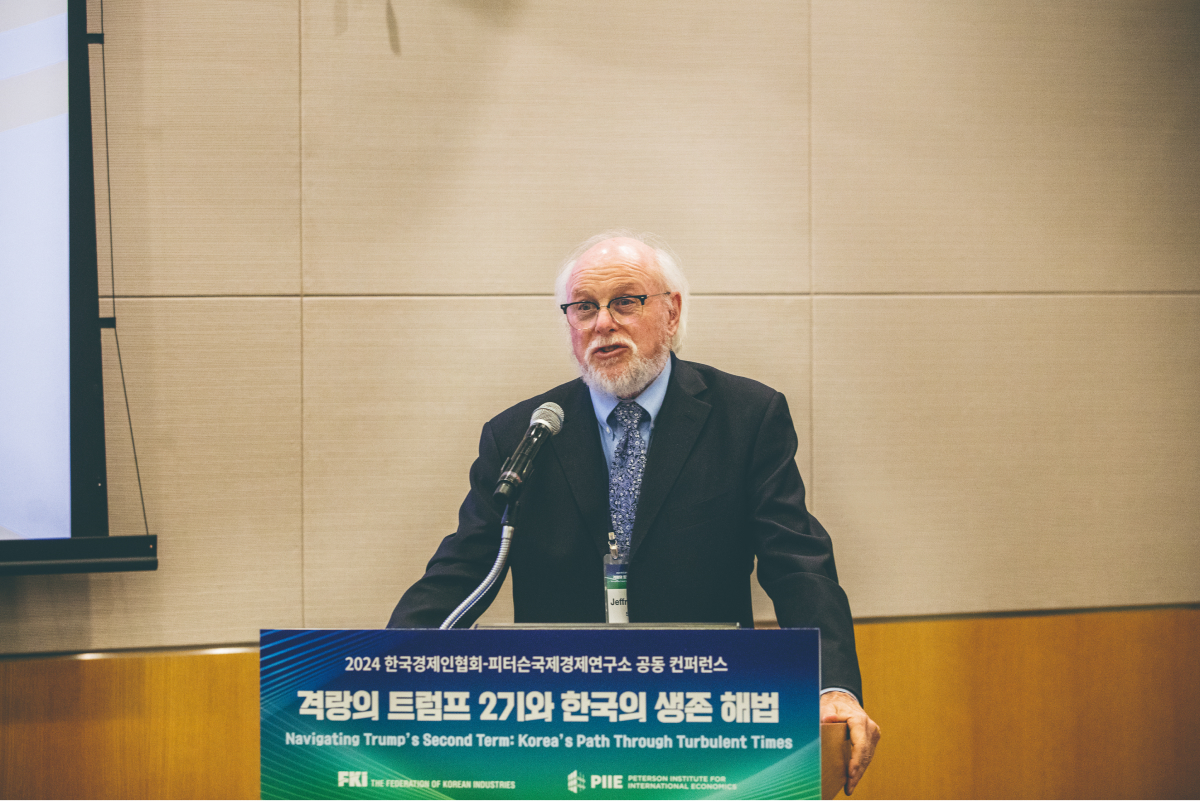
Jeffrey Schott
- Senior Fellow, Peterson Institute for International Economics
Trump’s Policy Priorities and Their Impact
Upon taking office on January 20, President Trump is expected to implement six priority policies immediately. Trump has consistently signaled a clear direction for these policies even before his reelection, demonstrating strong determination to implement them.
First, Trump is expected to revise and extend the Biden administration’s 2017 tax policies, reshaping them to align with his agenda. Second, largescale deportation of undocumented immigrants will be carried out. As part of his commitment to his supporters, Trump is likely to act on enforcing the deportation of undocumented immigrants immediately upon taking office. Third, Trump will intensify pressure on China by implementing aggressive tariff policies and export control measures.
Fourth, under his “America First” doctrine, Trump is expected to raise tariffs significantly as a means to protect US industries. Additionally, he will use tariff increases as a strategy to offset revenue losses from the new tax cuts that he plans to introduce in Congress.
Fifth, Trump will focus on strengthening national security by rebuilding the US military and its related industries. Given the lagging state of the US shipbuilding sector, which plays a vital role in naval strength, Trump is expected to remove regulations hindering the industry’s growth. He is also likely to expand cooperation with South Korea, which has a competitive edge in shipbuilding.
Sixth, Trump will prioritize support of domestic energy producers over international energy agreements. Specifically, he will continue to emphasize the role of LNG in reviving the US economy, fostering closer ties with South Korea, which excels in constructing LNG carriers.
The implementation of these priority policies will likely exacerbate the US fiscal deficit, potentially leading to budget cuts for the Biden administration’s Inflation Reduction Act (IRA) and CHIPS Act. Ultimately, this could further strengthen the US dollar.
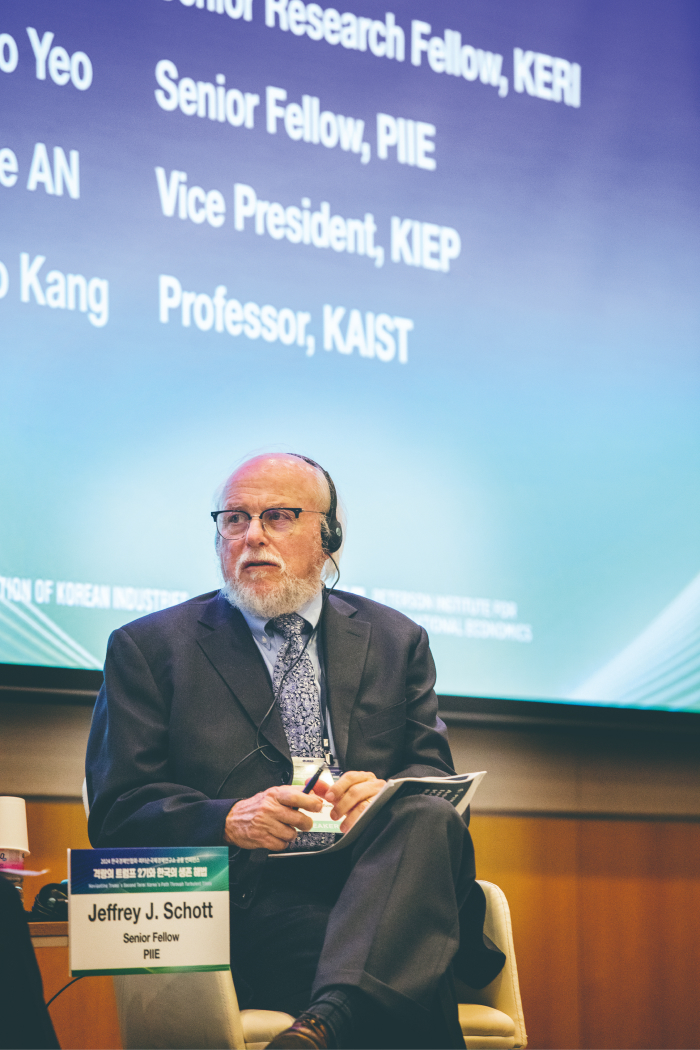
“Korea needs to develop
Korea-US relations through
“win-win” industrial
cooperation initiatives, and
proactively strengthen ties
with other major countries.”
“Korea needs to develop
Korea-US relations through
“win-win” industrial
cooperation initiatives, and
proactively strengthen ties
with other major countries.”
Outlook and Impact of Tariff Policies
One of the most alarming aspects of Trump’s priority policies for many countries is the tariff policy. Tariff measures are expected to be implemented more swiftly than anticipated immediately after his inauguration, with differentiated approaches for each country. Initially, Trump is likely to impose a universal tariff across all nations, whether allies or adversaries. However, targeted tariffs will most likely be applied to countries with which the US has a significant trade deficit. Countries with the largest trade deficits are China, Mexico, and Vietnam, and their tariff policies are expected to be included in the policy package to be announced within the first 100 days of his presidency. For Chinese imports, a strong 60% tariff is anticipated.
In addition, President Trump may introduce tariffs aimed at specific industries. With the automotive sector accounting for 25% of the US trade deficit, this industry is likely to become a target of tariffs. For South Korea, it is crucial to note that 72% of the trade deficit with the US comes from the automotive sector. Therefore, South Korea must be cautious of potential tariff measures targeting this industry. When exporting vehicles to the US, it will be essential to consider origin regulations on parts and intermediate goods used in the cars to avoid severe penalties from excessive tariffs.
Breakthrough to Strengthen Korea-US Relations
Since policy shifts are expected to be significant around these priorities, South Korea must respond quickly and proactively. South Korea should propose a “Korean Offer,” aiming for a “win-win” scenario in industry cooperation projects where mutual interests are aligned. As Trump’s second term is expected to involve increased pressure on China through new regulations and export controls, South Korea should deepen its relationship with the US. In particular, South Korea should enhance cooperation with the US in areas where it holds global competitiveness, such as automotive, semiconductors, defense, and shipbuilding. By doing so, South Korea can further strengthen the bilateral relationship.
South Korea should also strengthen its relationships with other major countries. Trump is likely to push for the US’s withdrawal from the WTO and the abolition of the IndoPacific Economic Framework (IPEF), undermining the rulesbased international order. As the US retreats, however, South Korea must take proactive steps to establish a rulesbased international order by cooperating with other nations and promoting multilateral trade initiatives. In particular, South Korea should consider joining the CPTPP to secure a stable supply chain and encourage the EU to join as well. South Korea’s leadership in this area will ultimately contribute to strengthening the country’s relationship with the US.
